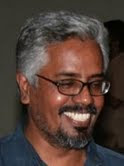Ravindran aka Chinta Ravi
Departure of a Radical Pilgrim
If one were to identify Raveendran a.k.a. Chinta Ravi (1946-2011) with any single characteristic, it would be that of a traveller. Throughout his life, he was fond of journeys – both inward and outward. Shunning all bonds and boundaries, he journeyed across various spaces – all along Kerala, the tribal belt of India and abroad, across genres – journalism, art criticism, film review, cultural studies, travelogue, stories, narration and commentary, and across media – print, film and television. And the ideal traveller that he was, he travelled light: with his commitment to Marxian ideals, concern for the downtrodden, and passion for art .
Midnight's Child
A typical ‘Midnight's Child' of Kerala, born in Kozhikode, Ravi was part of progressive movements and made his mark as a writer by publishing a novelette ‘Athiranipookkal' when he was a student. After completing a journalism course in Mumbai, he came back to Kerala and began penning political articles and features on art and cinema in publications such as Searchlight , Chinta (the ideological mouthpiece of the Marxist party), and Kalakaumudi .
Ravi catalysed critical writing in Malayalam by introducing New Left ideas and ideological criticism. Both in life and writing, Ravi followed the struggles and crises in Marxian ideology and aesthetics, globally and locally. ‘Kalavimarsham: Marxist Manadhandam' (1983), the path-breaking anthology he edited, was a qualitative leap in critical thinking in Malayalam that brought together an array of eminent thinkers to address vital issues relating to politics, art, literature, film, and spirituality. He was always adept at developing apt theoretical terms and concepts in Malayalam, he imaginatively drew words, phrases and usages from local dialects, everyday speech, and Sanskrit, freely mixing them to create a fresh idiom that was simple yet intense.
His travelogues opened up the sensualities of alien lands, evoking our senses through minute descriptions of sights, noises, scents, people, places, and events around him, peppered with a keen sense of history. And all his journeys were to the margins. His best writings are undoubtedly about the tribal people of India from Andhra Pradesh to the North-East, which are rich in ethnographic details and insights.
The three films he made also resonate with the same energy of critique and resistance that charge his writings. Ironically, if his life and writings were all about relentless journeys, his films deal with social and political stasis and the efforts to break away. His first film ‘Harijan' (Telugu) was about downtrodden communities in rural Andhra in the cusp of a political crisis and rebellion. ‘Iniyum Marichhittillatha Nammal' (1980) was about a group of radical youth caught within an oppressive social system that envelops them. Ravi described this film as a ‘film essay,' a treatise that grapples with the dilemma of contemporary youth torn between thought and action, dreams and reality. ‘Ore Thooval Pakshikal' (1988) set against the historical background of the last days of British Raj, is a film that excavates the origins of class consciousness in a remote rubber plantation in Malabar.
Pioneer of art criticism
Ravi was also the pioneer of art criticism. He was fellow traveler of the Indian Radical Painters and Sculptors Association during their show at Kozhikode in 1989. This show, under the leadership of mercurial sculptor Krishnakumar, challenged the art establishment up front , and was the first one of its kind in the country that brought together a number of young artists, who were to dominate Indian art scene in the next decades. Many artists such as Ganesh Pyne, Laxma Goud, and C.N. Karunakaran were close to Ravi, about all of whom he wrote with great sensitivity and detail.
In the 90s Ravi turned to television and made several innovative programmes on art, history, and culture for Doordarshan, Asianet (‘Ente Keralam'), and later, for Real Estate Television (about the architecture and habitat of various South Indian communities). ‘Ente Keralam' (1994 to 1999) was a meandering journey through the everyday life and culture of the State. By introducing people from various walks of life, obscure institutions and events, Ravi held up a mirror towards the often forgotten facets of Kerala's pluralistic culture and its inexorable transformations.
The rich and varied oeuvre of Ravi also follows the radical paradigm shifts in Malayali life, culture, and politics during the last decades, whether it be the tremors of the Naxalite movement, theoretical forays of cultural/art criticism, counter aesthetics in filmmaking, or television programming. A leftist to the core, Ravi never pontificated or sloganeered in his writings and always shunned the vulgarity of the mainstream. Throughout his life, he assiduously kept away from positions of power of all kinds. Ravi revelled in friendship and camaraderie, exuding a certain lightness and vigour in his carriage and demeanour, and in all his exchanges and engagements with the world.
In a way, every traveller shuns destinations, fearing it would end the journey. And like a typical traveller, Ravi too was acutely aware of lands not-yet-visited and destinations unrealised. Towards the end of his life, a feeling that his generation never realised its potential seemed to haunt Ravi. He said in one of his last interviews: “Personally, I think my interests were fragmented; I could never achieve completion in my writings or cinema, nor did I persist long enough with any. I was driftwood of sorts. It happened with many people in my generation, we were caught up in too many flows...” Obviously, it was such frankness and courage to introspect that made and continues to make Ravi dear to all.




